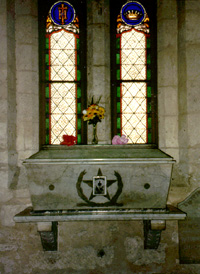Group Targets
Remains of Alamo Heroes
Defender's Relatives Want Church
Sarcophagus Opened to Study Disputed Bones
By Christopher Anderson, San Antonio Express-News Staff Writer, 02/24/96
 Sealed
in a marble tomb and on display inside San Fernando Cathedral for the past
58 years are bones and skulls that the Catholic Church says are of legendary
Alamo defenders David Crockett, William Travis and Jim Bowie.
Sealed
in a marble tomb and on display inside San Fernando Cathedral for the past
58 years are bones and skulls that the Catholic Church says are of legendary
Alamo defenders David Crockett, William Travis and Jim Bowie.
Historians and archaeologists, however, have questioned that claim ever since human remains were found in 1936 by workers digging the church foundation to make way for a new altar.
Now the leader of a 1-year-old group of direct descendants of participants in the 1836 Battle of the Alamo wants the sarcophagus opened and the contents scientifically examined.
"I just want the truth," said Lee Spencer, president of the Alamo Defenders Descendants Association. "I don't know if my people are in San Fernando Cathedral. But I think it's time to answer the question.
"I would like the Smithsonian to determine No. 1, if they have been in a fire. And if they have been in a fire, I'd like to have DNA testing done. This is one of the big Alamo mysteries and nobody's ever talked about it."
Spencer, who is to place a wreath inside the cathedral today to honor the slain defenders, said she wants the remains to stay at San Fernando even if they include those of Gordon C. Jennings, her own ancestor and the oldest Alamo defender.
The rector of San Fernando Cathedral said he had only recently learned of the request and would need to consult with Archbishop Patrick Flores and other officials before responding to Spencer.
"To me this is an unusual request and it's also a very delicate one," the Rev. David Garcia said.
Forensic anthropologist Doug Owsley of the Smithsonian National Museum of Natural history said a greal deal could possibly be learned from examining the remains.
Age, race, sex, evidence of trauma, such as gunshot wounds, whether they were burned and how many people they are from could be determined depending on the extent and condition of the remains, Owsley said.
And their identities even could be established. In one of the more widely publicized cases, skeletal remains believed to be of Nicholas II, the last czar of Russia, were linked to his known descendants through DNA.
"It's not out of the realm of possibility to get DNA from ancient bones," Oswell said. "The way the field has changed, it's like night and day since 1936."
"There's quite a bit you can tell. It looks like it would be an interesting project. If we became involved for something like that, we'd probably do it as a public service."
The entombed remains originally were found in a mysterious box in the same year the city celebrated the Battle of the Alamo's 100th anniversary. They were declared to be "Alamo Heroes" by then Archbishop Arthur Jerome Drossaerts.
Succeeding archbishops, including Robert E. Lucey, distanced themselves from Drossaerts' assertion, said Brother Edward Lock, an archivist for the Archdiocese of San Antonio.
Lock said Archbishop Lucey once asked: "If they are heroes of the Alamo, then what are they doing in a Mexican church? And if they are Mexicans why are they being honored as Alamo heroes?"
While archaeologists and historians are highly skeptical that the remains are from Alamo defenders - and even say it's more likely they are from Mexicans killed in an earlier battle - at least one is open to the possibility.
"It's always been a fervent hope we would find something," said Waynne Cox, a research associate at UTSA's Center for Archaeological Research and one of the skeptics.
Source: San Antonio Express-News, Saturday, February 24, 1996, pages 1B & 5B.
Related Documents:
Group wants to determine if bones
belong to Alamo martyrs
Casualties
of the 1836 Siege
The Forgotten Sacrifices of Tejanos
Historian Points Out Alamo Heroes' Flaws
José Francisco Ruiz's account of the Fall of
the Alamo
The Story of Enrique Esparza - 11/22/1902
Battle of the Alamo from Survivor's Lips
Mythologizing The Alamo
Alamo Myths